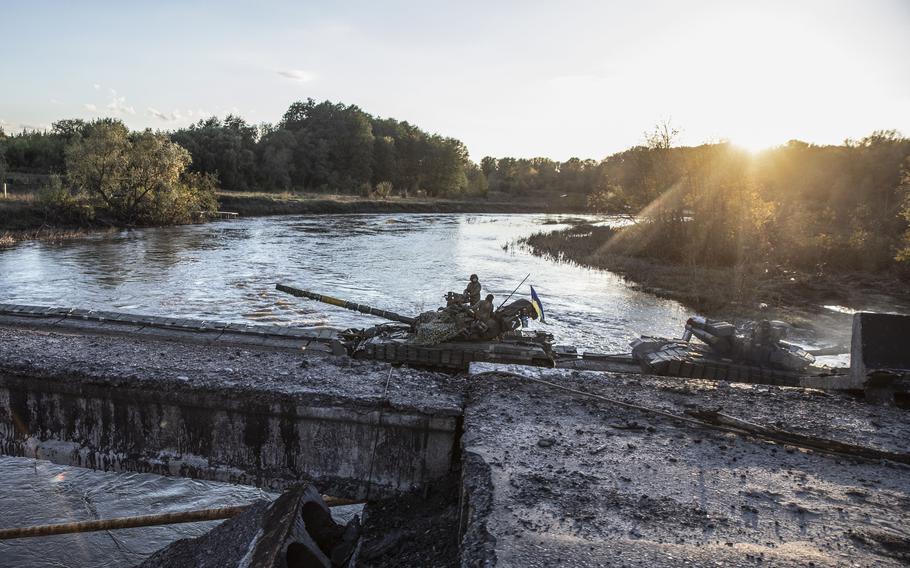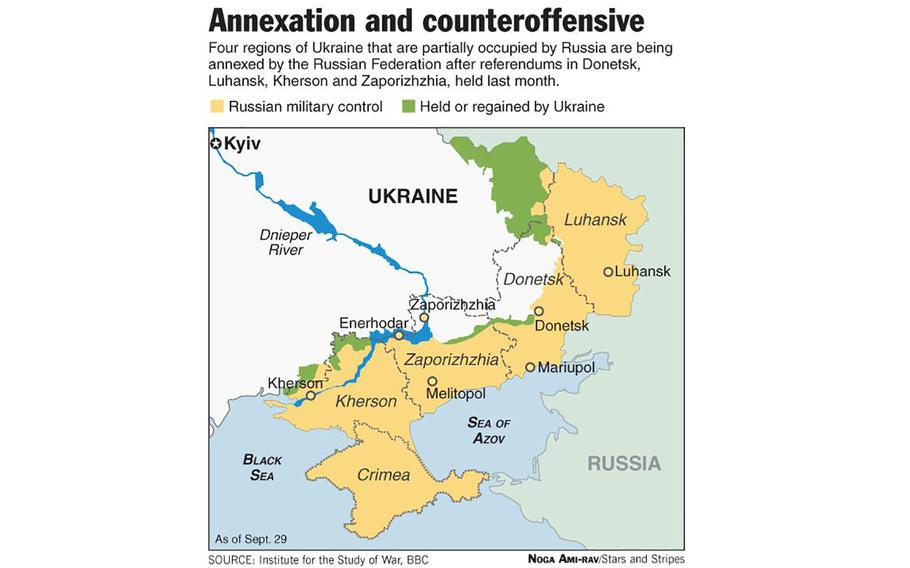Europe
Ukraine hammers Russian forces into retreat on east and south fronts
The Washington Post October 4, 2022

Ukrainian forces on a tank pass a pontoon bridge over the Oskil River in the Kharkiv Oblast on October 3. (Heidi Levine/for The Washington Post)
Ukrainian troops on Tuesday accelerated their military advances on two fronts, pushing Russian forces into retreat in the Donetsk and Luhansk regions to the east and in the Kherson region to the south.
The gains showed Kyiv continuing to recapture occupied territory on the same day that Russian President Vladimir Putin and his rubber-stamp parliament sought to formalize their increasingly far-fetched “annexation” of four Ukrainian regions.
“The Ukrainian armed forces commanders in the south and east are throwing problems at the Russian chain of command faster than the Russians can effectively respond,” said a Western official who briefed reporters about sensitive security information on the condition of anonymity. “And this is compounding the existing dysfunction within the Russian invasion force.”
Ukraine has been pushing to take back as much of its occupied territory as it can before Russia potentially sends hundreds of thousands of reinforcements to the battlefield, following a recent mobilization effort.
The Ukrainian counteroffensive, which had moved far more slowly in the south compared with the lightning push through the northeastern Kharkiv region in September, has suddenly picked up speed, with Russian units retreating in recent days from a large swath of territory along the west bank of the Dnieper River.
Ukrainian forces pushed ahead dozens of miles into the southern Kherson region, liberating towns and villages in scenes reminiscent of those from mid-September, when they swept into Kharkiv and were greeted by joyful residents who had spent many months under Russian occupation.
On Monday, the spokesperson for the Russian Defense Ministry acknowledged that “superior tank units” of Ukraine had “wedged in the depth of our defense line” near the villages of Zolota Balka and Oleksandrivka in the Kherson region.
Ukrainian President Volodymyr Zelensky said late Monday that the 129th Brigade from his native city of Kryvyi Rih had liberated the settlements of Arkhanhelske and Myrolyubivka.
A video shared on social media by soldiers from the Ukrainian navy’s 35th Marine Infantry Brigade showed the capture of Davydiv Brid, which delivered a major blow to Russian supply lines in the Kherson area.
Regaining control of Kherson, a rich agricultural region whose capital boasts a key port where the Dnieper flows into the Black Sea, is critical for Ukraine. Its capital was the first significant city captured by Russia at the start of its invasion in late February, and its loss would be a severe setback for Russia — strategically crippling for the military and politically humiliating for Putin.

()
As the only position the Russians hold west of the Dnieper, Kherson is a potential strategic springboard for Russia to launch any future offensive down the Black Sea coast toward the storied port city of Odessa.
Ukrainian officials had touted an operation to liberate Kherson for months. But until now, its forces had struggled in the south, suffering heavy casualties and making few territorial advances.
The Ukrainian gains in Kherson follow the recapture over the weekend of the strategic transit hub of Lyman, in eastern Donetsk. The Ukrainians have now pushed through Lyman, apparently intent on extending their gains into Luhansk, the region where Russia has maintained its strongest grip.
The collapse of the Russian position in Lyman occurred just as Putin was claiming that the city and all of the Donetsk region, along with Luhansk, Kherson and Zaporizhzhia, were annexed and restored to Russia as part of its historical lands. But unlike in Kharkiv, where Moscow ordered a retreat, Russian forces had apparently been told to defend Lyman.
“All Russian forces withdrew in poor order, suffering high casualties from artillery fire as they attempted to leave,” the Western official said of Lyman, comparing it to Kharkiv. “Then, as you recall, troops received an order to cede the territory,” the official said. “But in Lyman, we think that the Russian troops retreated despite orders to defend and remain.”
“Relinquishing this area is exactly what the Kremlin did not want to happen,” the official said.
As a result, Russian control over the Luhansk region, which was mostly uncontested since June, is now also in jeopardy.
The Institute for the Study of War (ISW), a Washington-based think tank, said geolocated footage corroborates statements from Russian military figures that Ukrainian troops are continuing their advance east of Lyman, apparently gearing up for a fight over the town of Kreminna.
The new round of Russian setbacks revived debates over Kremlin strategy among pro-Russian military bloggers, who for months have provided a more detailed and less censored look into the war campaign than Moscow’s official military reports.
“I am now being reproached for driving people into depression with my news,” Alexander Kots, a military correspondent for Komsomolskaya Pravda newspaper, wrote Tuesday on his Telegram blog, which has more than 600,000 subscribers. “Well, there will be no good news in the near future neither from the Kherson front, nor from now Luhansk.”
Videos posted by Russian independent outlet Astra show pro-Russian fighters from the self-proclaimed Luhansk People’s Republic camping out in an open field and complaining that Russian commanders abandoned them as they withdrew.
In the videos, a man in worn-out fatigues said the Russian losses in the area were huge, with only 193 survivors and a few pieces of heavy equipment left from their initial convoy. The Washington Post could not independently verify the video clips.
Another popular Russian war blogger, known as Rybar, posted maps showing how the Russian hold on the Kherson region shrank dramatically in the span of just a few hours. Losing the west bank of the Dnieper River to Ukrainian control would be “an immediate danger” for remaining Russian units in the area, Rybar wrote to his nearly 1 million followers.
As Russia was retreating on the battlefield, Zelensky signed a decree Tuesday formally refusing any negotiations with Putin — a largely symbolic move to show Kyiv’s confidence in its military position.
Meanwhile, the political theater continued in Moscow, where the Federation Council, the upper chamber of the Russian parliament, rubber-stamped Putin’s annexation of the four Ukrainian regions.
Putin and other officials have warned that Russia would feel entitled to defend its newly seized territories by all possible means — including, potentially, the use of nuclear weapons.
The annexation legislation now passes back to the Kremlin for Putin’s final signature, which from Russia’s perspective would complete the process of seizing more than 15 percent of all Ukrainian sovereign territory.
Putin’s brazen land-grab attempt was met with overwhelming international condemnation. Even countries that traditionally maintain closer ties to Moscow, such as Turkey and Serbia, have joined Western nations in refusing to recognize the annexation.
Putin now appears to be betting on the unpopular mobilization drive that aims to call up hundreds of thousands of men to help hold ground in the annexed regions.
Russian Defense Minister Sergei Shoigu announced Tuesday that more than 200,000 men have been sent to the Russian armed forces in the two weeks since Putin announced the mobilization on Sept. 21.
At the same time, the interior minister in neighboring Kazakhstan, Marat Akhmetzhanov, said that an equivalent number of Russians — about 200,000 — had crossed that country’s border since Sept. 21, most of them fleeing the mobilization or leaving out of fear that Putin would soon impose martial law and ban international travel. Tens of thousands more Russians have fled to other neighboring countries, including Georgia and Finland.
The botched mobilization has led to severe recriminations in Russia, with some governors expressing fury that men who are too old or otherwise unqualified are being wrongly called to duty.
Shoigu, the defense minister, tried to respond to a torrent of recent reports on Russian social media from mobilized men and their family members complaining about the lack of appropriate equipment in military units, which forced some newly enlisted soldiers to seek protective gear themselves.
“Officials have been instructed to provide the mobilized with the necessary sets of clothing and other equipment,” Shoigu said, adding that 80 training grounds across Russia are now accepting mobilized soldiers.
Ilyushina reported from Riga, Latvia; Khurshudyan from Dnipro, Ukraine; and Rauhala from Brussels. The Washington Post’s Robyn Dixon and Natalia Abbakumova in Riga contributed to this report.